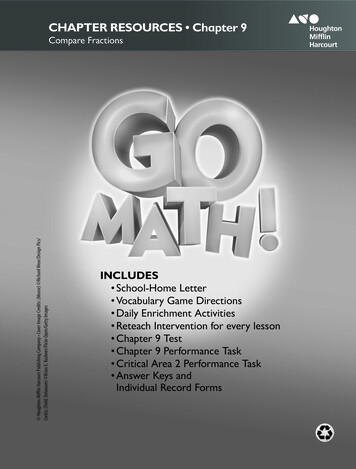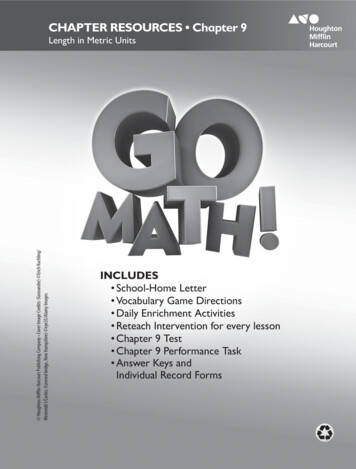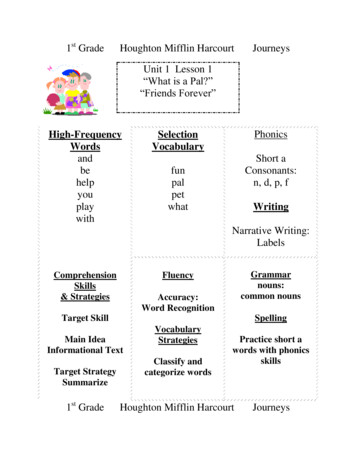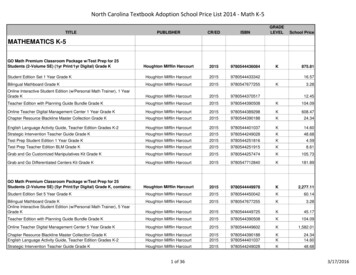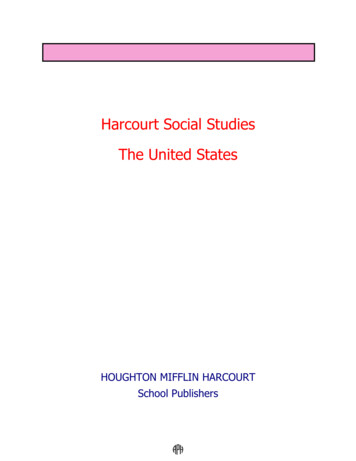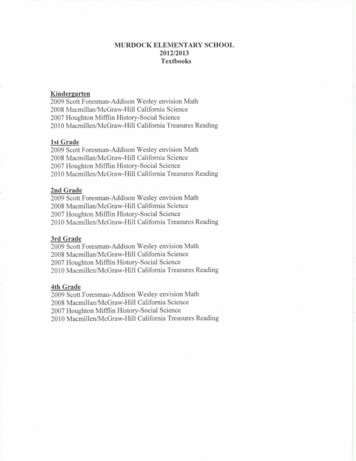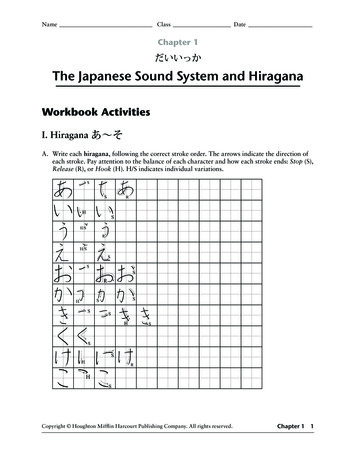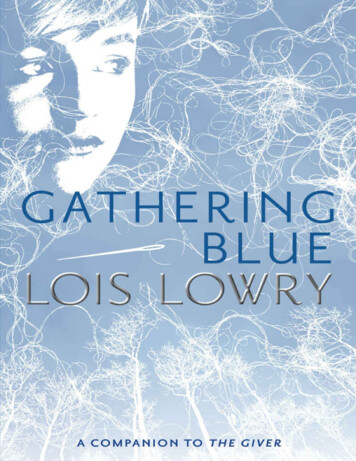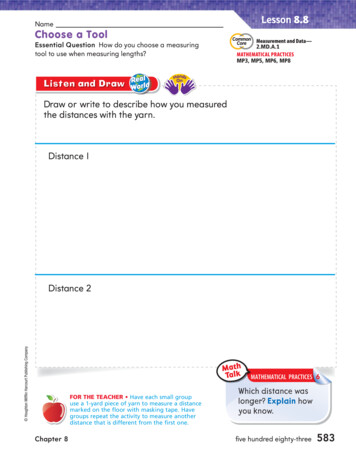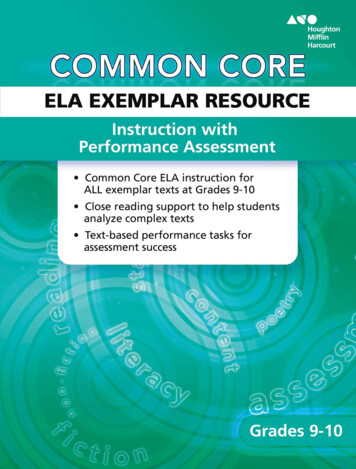
Transcription
HOUGHTON MIFFLIN HARCOURTCOMMON COREELA EXEMPLAR RESOURCEInstruction with Performance AssessmentGrades 9-10Copyright by Houghton Mifflin Harcourt Publishing CompanyAll rights reserved. No part of this work may be reproduced or transmitted in any form or by any means, electronic ormechanical, including photocopying or recording, or by any information storage or retrieval system, without the prior writtenpermission of the copyright owner unless such copying is expressly permitted by federal copyright law.Permission is hereby granted to individuals using the corresponding student’s textbook or kit as the major vehicle forregular classroom instruction to photocopy copying masters from this publication in classroom quantities for instructionaluse and not for resale. Requests for information on other matters regarding duplication of this work should be addressedto Houghton Mifflin Harcourt Publishing Company, Attn: Contracts, Copyrights, and Licensing, 9400 Southpark Center Loop,Orlando, Florida 32819-8647.Common Core State Standards Copyright 2010. National Governors Association Center for Best Practices and Council ofChief State School Officers. All rights reserved.This product is not sponsored or endorsed by the Common Core State Standards Initiative of the National GovernorsAssociation Center for Best Practices and the Council of Chief State School Officers.Printed in the U.S.A.ISBN 978-0-544-02790-91 2 3 4 5 6 7 8 9 10 XXXX450000000021 20 19 18 17 16 15 14 13 12ABCDEFGIf you have received these materials as examination copies free of charge, Houghton Mifflin Harcourt Publishing Companyretains title to the materials and they may not be resold. Resale of examination copies is strictly prohibited.Possession of this publication in print format does not entitle users to convert this publication, or any portion of it, intoelectronic format.
Table of ContentsAbout the Common Core ELA Exemplar ResourceOverview . . . . . . . . . . . . . . . . . . . . . . . . . . . . . . . . . . . . . . . . . . . . . . . . . . . . . . . viLiterature Discussion Groups . . . . . . . . . . . . . . . . . . . . . . . . . . . . . . . . . . . . . . . ix9–10 TEXT EXEMPLARSStoriesiiPageSuggestedPacingfrom The Odyssey by Homer . . . . . . . . . . . . . . . . . . . . . . . . . . . . . . . . . . . . . . . . 22 weeksfrom Metamorphoses by Ovid . . . . . . . . . . . . . . . . . . . . . . . . . . . . . . . . . . . . . . . 63 weeks“The Nose” by Nikolai Gogol . . . . . . . . . . . . . . . . . . . . . . . . . . . . . . . . . . . . . . . 101 weekCandide by F.A.M. de Voltaire . . . . . . . . . . . . . . . . . . . . . . . . . . . . . . . . . . . . . . 142 weeksFathers and Sons by Ivan Turgenev . . . . . . . . . . . . . . . . . . . . . . . . . . . . . . . . . . 183 weeks“The Gift of the Magi” by O. Henry . . . . . . . . . . . . . . . . . . . . . . . . . . . . . . . . . . 223 daysThe Metamorphosis by Franz Kafka . . . . . . . . . . . . . . . . . . . . . . . . . . . . . . . . . . 262 weeksThe Grapes of Wrath by John Steinbeck . . . . . . . . . . . . . . . . . . . . . . . . . . . . . . 303 weeksFahrenheit 451 by Ray Bradbury . . . . . . . . . . . . . . . . . . . . . . . . . . . . . . . . . . . . 343 weeks“I Stand Here Ironing” by Tillie Olsen . . . . . . . . . . . . . . . . . . . . . . . . . . . . . . . . 384 daysThings Fall Apart by Chinua Achebe . . . . . . . . . . . . . . . . . . . . . . . . . . . . . . . . . 422 weeksTo Kill a Mockingbird by Harper Lee . . . . . . . . . . . . . . . . . . . . . . . . . . . . . . . . . 462 weeksThe Killer Angels by Michael Shaara . . . . . . . . . . . . . . . . . . . . . . . . . . . . . . . . . 502 weeksThe Joy Luck Club by Amy Tan . . . . . . . . . . . . . . . . . . . . . . . . . . . . . . . . . . . . . . 543 weeksIn the Time of the Butterflies by Julia Alvarez . . . . . . . . . . . . . . . . . . . . . . . . . 583 weeksThe Book Thief by Marcus Zusak . . . . . . . . . . . . . . . . . . . . . . . . . . . . . . . . . . . . 623 weeksExemplar Instructional Resource
DramaPageSuggestedPacingOedipus Rex by Sophocles . . . . . . . . . . . . . . . . . . . . . . . . . . . . . . . . . . . . . . . . . . 661 weekThe Tragedy of Macbeth by William Shakespeare . . . . . . . . . . . . . . . . . . . . . . 702 weeksA Doll’s House by Henrik Ibsen . . . . . . . . . . . . . . . . . . . . . . . . . . . . . . . . . . . . . . 742 weeksThe Glass Menagerie by Tennessee Williams . . . . . . . . . . . . . . . . . . . . . . . . . . . 782 weeksRhinoceros by Eugene Ionesco . . . . . . . . . . . . . . . . . . . . . . . . . . . . . . . . . . . . . . 821 week“Master Harold” . . . and the boys by Athol Fugard . . . . . . . . . . . . . . . . . . . . . 861 weekPoetry“Sonnet LXXIII” by William Shakespeare . . . . . . . . . . . . . . . . . . . . . . . . . . . . . . 902 days“Song” by John Donne . . . . . . . . . . . . . . . . . . . . . . . . . . . . . . . . . . . . . . . . . . . . 922 days“Ozymandias” by Percy Bysshe Shelley . . . . . . . . . . . . . . . . . . . . . . . . . . . . . . . 942 days“The Raven” by Edgar Allan Poe . . . . . . . . . . . . . . . . . . . . . . . . . . . . . . . . . . . . 962 days“We Grow Accustomed to the Dark” by Emily Dickinson. . . . . . . . . . . . . . . . . 982 days“Loveliest of Trees” by A. E. Houseman . . . . . . . . . . . . . . . . . . . . . . . . . . . . . . 1002 days“Lift Every Voice and Sing” by James Weldon Johnson . . . . . . . . . . . . . . . . . 1022 days“Yet Do I Marvel” by Countee Cullen . . . . . . . . . . . . . . . . . . . . . . . . . . . . . . . 1042 days“Musée des Beaux Arts” by Wystan Hugh Auden . . . . . . . . . . . . . . . . . . . . . . 1062 days“Women” by Alice Walker . . . . . . . . . . . . . . . . . . . . . . . . . . . . . . . . . . . . . . . . 1082 days“I Am Offering This Poem” by Jimmy Santiago Baca . . . . . . . . . . . . . . . . . . . 1102 daysInformational Text“Speech to the Second Virginia Convention”by Patrick Henry . . . . . . . . . . . . . . . . . . . . . . . . . . . . . . . . . . . . . . . . . . . . . . . . . 1124 days“Farewell Address” by George Washington . . . . . . . . . . . . . . . . . . . . . . . . . . 1141 week“Gettysburg Address” by Abraham Lincoln . . . . . . . . . . . . . . . . . . . . . . . . . . . 1184 days“Second Inaugural Address” by Abraham Lincoln . . . . . . . . . . . . . . . . . . . . . 1204 daysTable of Contents iii
Informational Text (continued)ivPageSuggestedPacing“State of the Union Address”by Franklin Delano Roosevelt . . . . . . . . . . . . . . . . . . . . . . . . . . . . . . . . . . . . . . 1243 daysThe “Spirit of Liberty” Speech by Judge Learned Handpresented in 1944 during “I AM an American Day” . . . . . . . . . . . . . . . . . . . . 1284 days“Remarks to the Senate in Support of a Declarationof Conscience” by Margaret Chase Smith . . . . . . . . . . . . . . . . . . . . . . . . . . . . 1302 days“Letter from Birmingham Jail”by Martin Luther King Jr. . . . . . . . . . . . . . . . . . . . . . . . . . . . . . . . . . . . . . . . . . 1323 days“I Have a Dream: Address Delivered at the March on Washington, D.C.,for Civil Rights on August 28, 1963” by Martin Luther King Jr. . . . . . . . . . . . 1342 daysI Know Why the Caged Bird Sings by Maya Angelou . . . . . . . . . . . . . . . . . . . 1362 weeks“Hope, Despair and Memory” by Elie Wiesel . . . . . . . . . . . . . . . . . . . . . . . . . 1402 days“Address to Students at Moscow State University” by Ronald Reagan . . . . . 1423 days“A Quilt of a Country” by Anna Quindlen. . . . . . . . . . . . . . . . . . . . . . . . . . . . 1442 daysfrom Bury My Heart at Wounded Knee: An Indian History of theAmerican West by Dee Brown . . . . . . . . . . . . . . . . . . . . . . . . . . . . . . . . . . . . . 1462 weeksfrom Son of the Morning Star: Custer and the Little Bighornby Evan S. Connell . . . . . . . . . . . . . . . . . . . . . . . . . . . . . . . . . . . . . . . . . . . . . . . 1502 weeksfrom The Story of Art by E. H. Gombrich . . . . . . . . . . . . . . . . . . . . . . . . . . . . . 1541 weekCod: A Biography of the Fish That Changed the Worldby Mark Kurlansky . . . . . . . . . . . . . . . . . . . . . . . . . . . . . . . . . . . . . . . . . . . . . . . 1582 weeksBlack, Blue & Gray: African Americans in the Civil War by Jim Haskins . . . . . 1622 weeksThe Longitude Prize by Joan Dash . . . . . . . . . . . . . . . . . . . . . . . . . . . . . . . . . . 1661 weekfrom The Illustrated Book of Great Composers by Wendy Thompson. . . . . . 1702 weeksfrom 1491: New Revelations of the Americas Before Columbus byCharles C. Mann . . . . . . . . . . . . . . . . . . . . . . . . . . . . . . . . . . . . . . . . . . . . . . . . . 1743 weeksfrom Elements by Euclid . . . . . . . . . . . . . . . . . . . . . . . . . . . . . . . . . . . . . . . . . . 1781 week“Classifying the Stars” by Annie J. Cannon . . . . . . . . . . . . . . . . . . . . . . . . . . . 1821 week“Amusement Park Physics” by Jearl Walker . . . . . . . . . . . . . . . . . . . . . . . . . . 1861 weekfrom The Hot Zone: A Terrifying True Story by Richard Preston . . . . . . . . . . 1902 weeksfrom Life by the Numbers by Keith Devlin. . . . . . . . . . . . . . . . . . . . . . . . . . . . 1941 weekThe Race to Save the Lord God Bird by Phillip Hoose . . . . . . . . . . . . . . . . . . . 1982 weeksExemplar Instructional Resource
Informational Text (continued)PageSuggestedPacingfrom The Story of Science: Newton at the Center by Joy Hakim . . . . . . . . . 2021 weekfrom Circumference: Eratosthenes and the Ancient Quest to Measurethe Globe by Nicholas Nicastro . . . . . . . . . . . . . . . . . . . . . . . . . . . . . . . . . . . . . 2061 weekRecommended Levels of Insulation from U.S. Environmental ProtectionAgency/U.S. Department of Energy . . . . . . . . . . . . . . . . . . . . . . . . . . . . . . . . . 2102 daysStudent Selection Copy Masters“Loveliest of Trees” by A. E. Housman . . . . . . . . . . . . . . . . . . . . . . . . . . . . . . . 212“Sonnet LXXIII” by William Shakespeare . . . . . . . . . . . . . . . . . . . . . . . . . . . . . 213“Ozymandias” by Percy Bysshe Shelley . . . . . . . . . . . . . . . . . . . . . . . . . . . . . . 214Academic Vocabulary. . . . . . . . . . . . . . . . . . . . . . . . . . . . . . . . . . . . . . . . . . . 216Performance Task Student Checklists and RubricGrade 9–10 Writing . . . . . . . . . . . . . . . . . . . . . . . . . . . . . . . . . . . . . . . . . . . . . . 222Grade 9–10 Speaking and Listening . . . . . . . . . . . . . . . . . . . . . . . . . . . . . . . . . 223Performance Rubric . . . . . . . . . . . . . . . . . . . . . . . . . . . . . . . . . . . . . . . . . . . . . . 224Bibliography. . . . . . . . . . . . . . . . . . . . . . . . . . . . . . . . . . . . . . . . . . . . . . . . . . . 226Internet Resources . . . . . . . . . . . . . . . . . . . . . . . . . . . . . . . . . . . . . . . . . . . . .228Table of Contents v
OverviewThe Common Core ELA Exemplar Resource was developed to provide instructionfor the Grades 9–10 text exemplars listed in Appendix B of the Common Core StateStandards for English Language Arts.Use this guide to complement the reading instruction of exemplars within yourliterature program or use it separately to provide students with questionsand activities that deepen their comprehension of text exemplars selected forindependent reading or group discussion.Text ExemplarsThe list of text exemplars provided inAppendix B of the Common Core StateStandards for English Language Arts wascompiled based on the texts’ quantitativeand qualitative complexity, quality, andrange.The text exemplars are presented in bandsof two grade levels each (9–10 and 11–12)and are meant to suggest “the breadth oftexts that students should encounter in thetext types required by the Standards.” Theworks listed were never intended to serveas a partial or complete reading list butrather as a guide to the types of readingmaterials that will help students successfullymeet the Standards.Organization ofThis GuideThis guide is organized into three parts.CONTENTS WITH SUGGESTED PACINGThe table of contents lists all the exemplarsin the order given in Appendix B, alongwith the page references for where to findeach exemplar in this resource. You willneed to select and obtain the textsseparately. This section also includessuggested pacing for reading eachexemplar and teaching its lesson.EXEMPLAR LESSONS Most lessons forstories and informational texts are fourpages, while most lessons for poetry aretwo pages. See Lesson Setup on p. vii formore information.ENDMATTER RESOURCES Copying Masters In the back of thisguide, you will find copying masters forseveral public-domain text exemplars,provided for your convenience. Student Performance Checklists Thesechecklists will help students assess theirwriting and speaking and listening.viExemplar Instructional Resource
Academic Vocabulary This compilationlists all the academic vocabulary, or Tier 2words, introduced and defined in eachlesson. Bibliography and ExemplarWebsites These sections include thebibliographic information for eachexemplar included in this guide, aswell as a list of useful websites that offeradditional information for teaching theexemplars and implementing theStandards.Lesson SetupHere is the basic setup of a four-pagelesson.PAGE 1 The first part of each lessonprovides background information aboutthe text and guidance for introducing thelesson to the class. The following featuresare included: Objectives Suggested Instructional Segments Options for ReadingPAGES 2–4 Each lesson includes two setsof questions that correspond to a “FirstRead” and a “Second Read” of the text. First-Read Questions Use these questionsduring and after an initial reading of thetext to help students think through thetext and learn to cite text evidence intheir responses. Second-Read Questions Use thesequestions to guide students througha deeper analysis of the text. Thesequestions give students opportunitiesfor close reading and ask them to makedeeper connections between ideas. Here,too, students must cite text evidence tosupport their ideas.PERFORMANCE TASK Each lessonculminates in a performance task inwhich students are asked to demonstrateunderstanding of the exemplar text.Within each task, students are expectedto complete a short writing assignment aswell as engage in a speaking and listeningactivity. Where applicable, the performancetask matches the performance-tasksuggestion provided in Appendix B. Summary About the Author Discuss Genre and Set Purpose Text Complexity Rubric Common Core State Standards metOverview vii
Additional LessonFeaturesTEXT COMPLEXITY RUBRIC To help youassess text complexity at a glance, a rubricis provided in every lesson. It identifies theoverall complexity as Accessible, Complex,or More Complex. The rubric also includesquantitative measures for the Lexile andshows qualitative measures on a four-pointcontinuum with text-specific rationales.DOMAIN SPECIFIC VOCABULARY Thesecontent-area Tier 3 words are included onlyfor texts with heavy discipline-specificcontent. Students are likely to use thesewords only within a specific discipline, suchas centrifugal in science.INDEPENDENT/SELF-SELECTEDREADING This feature, included on thelast page of every lesson, suggests twoon-level developmentally and ageappropriate books students might usefor independent reading and additionalapplication of the Standards addressed inthe lesson.RESPOND TO SEGMENT—ClassroomCollaboration These activities are aimed tohelp students wrap up each segment oftext. Students summarize what they’vealready learned and address any questionsthey have before moving on.viiiExemplar Instructional ResourceTips for Getting Started Review the list of text exemplars for yourgrade span. The exemplars include avariety of classic and contemporarycomplex texts. Many of the texts willlikely relate to cross-curricular topicsalready present in your current curriculumand can be used as supplementarymaterial to further discuss a given topic. Consider the needs and the readinglevels of the students in your classroom.Each list of exemplars covers a two-gradespan, so some titles may not be at theright level for your class at a given pointin the year. Use the text complexity rubricto help you select the exemplars that bestsuit your students’ reading or listeningcomprehension abilities throughout theschool year. Work with your school librarian. Yourlibrarian can help you find copies of theexemplar texts, online magazine articles,and any poems and stories that are in thepublic domain. Preview the exemplars. As you preparefor a lesson, make notes to help youconsider additional connections thatstudents can make to the text and howyou might best prepare them for readingand discussion.
Literature Discussion GroupsThe Common Core ELA Exemplar Instructional Resource can be effectivelyimplemented with literature discussion groups. You can support students incollaborative discussion to further explore the text exemplars in ways that canfoster higher-level thinking and the use of comprehension strategies, vocabularyacquisition, and speaking and listening skills—all essential for meeting theCommon Core State Standards for English Language Arts. Use the following tips.Before ReadingFirst ReadDivide students into small mixed-proficiencygroups and schedule a time for the groupsto meet each day. Assign roles to studentsor allow them to choose their own. Possibleroles include the following:Have groups read a segment of the text. Discussion Director moderates thediscussion by asking questions providedby the teacher or by creating originalquestions to pose to the group. Passage Finder chooses passages thatare particularly interesting, revealing, orchallenging for the group to focus on. Vocabulary Detective identifies andrecords unknown words for the groupto look up and discuss. Connector makes connections betweenthe text and other texts and aspects ofreal life, either in general terms or inrelation to the students’ experiences. Summarizer summarizes the segment oftext read by the group or the teacherprior to the group’s discussion anddescribes major characters, settings,and events, or main ideas and details.Discuss Genre and Set Purpose As groupsbegin to discuss the text, encourage them to identify elements of the text’s genre andname other texts in that genre. consider the author’s purpose in writing. review their purpose for reading. Ask students to take notes or flag sectionsof the text to later discuss and cite as textevidence. Have each group’s Summarizer offer asummary of what was read. Others canadd missing information as needed. Provide Discussion Directors withquestions from the lesson or have themmake up their own questions. Guide students to use the context of thetext to understand academic vocabulary. Monitor discussions to ensure groups stayfocused and cite text evidence to supportresponses.Second ReadHave each group reread portions of thetext to further analyze ideas and concepts. Guide groups to connect a segmentto previous segments. Ensure theyunderstand how the segments andideas build throughout the text. Help groups focus on figurative languageand literary elements, such as theme. Have groups support their responses withevidence from the text. Wrap up the discussion by having studentssummarize what they’ve learned.Literature Discussion Groups ix
DOMAIN: LiteratureLESSON TOPIC:STORIESHeroismOBJECTIVESfrom The Odyssey Describe how charactersrespond to major events Identify the theme of a storyby Homer, translated by Robert Fagles Interpret symbols andfigurative language in fiction Analyze text using textevidenceThis excerpt from The Odysseyis broken into threeinstructional segments.SEGMENTSSEGMENT 1. . . . . . pp. 152–178SEGMENT 2. . . . . . pp. 179–210SEGMENT 3. . . . . . pp. 211–248Options for ReadingSUMMARY The Odyssey tells the story of Odysseus, a Greek king andhero of the ten-year Trojan War, and his many adventures trying to returnhome to Ithaca after the war. In the poem, he is called the “man of twistsand turns” because he was fated to take so many detours during histen-year voyage home. This excerpt describes a few of these adventures.ABOUT THE AUTHOR Homer is the most famous of ancient Greek epicpoets, the author of both The Iliad (the story of the Trojan War) and TheOdyssey. However, no one is actually sure if Homer ever existed. TheGreeks believe he was a blind storyteller from the island of Chios.Discuss Genre and Set PurposeIndependent Students readthe book independently orwith a partner and thenanswer questions posed by theteacher.EPIC POEM Point out that The Odyssey is an epic poem, which is a typeof story that includes heroic characters, exotic settings, and grandioseevents. Discuss how elements of this story are mythical and imaginary,but add that even though realism is not the goal of an epic poem, thecharacters’ motives and behavior are very realistic.Supported Students read asegment and answer questionswith teacher support.SET PURPOSE Help students set a purpose for reading, such as toconsider the character of Odysseus and what kind of a hero he makes.TEXT COMPLEXITY RUBRICTfrom The OdysseyOverall Text ComplexityFICTIONMORE COMPLEXQuantitativeMeasureLexileText StructureLanguage Conventionalityand ClarityCommon CoreConnectionRL 1 cite textual evidence to support analysisof what the text says explicitly as well asinferences drawn; RL 3 analyze how charactersdevelop and interact with others; RL 4determine the meaning of words and phrases,including figurative and connotative meanings2Exemplar Instructional ResourceQualitativeMeasuresKnowledge DemandsPurpose/Levels of Meaning1050Lcomplex, unfamiliar story conceptssome figurative language and unfamiliarwordsmultiple themes, cultural and literaryknowledge usefulmultiple levels of meaning
SEGMENT 1 pp. 152–178Academic VocabularyRead each word with students and discuss its meaning.chided (p. 169) scoldedassail (p. 169) attackbeguiled (p. 170) charmed or pleasantly distractedstaunchly (p. 174) firmly or with confidencesuppliants (p. 174) people who ask humbly for helpflouting (p. 177) disregarding or treating with disdainFIRST READThink Through the TextENGLISH LANGUAGELEARNERSUse Descriptive WordsGuide students to generateadjectives that coulddescribe Odysseus. Thenhave them orally completelists of descriptors such asthe following:Odysseus can be described as. Sample answers:crafty, sneaky, strong,well-spoken, lordly, hardy,cunning, emotional, brave,fierceHave students use text evidence and draw inferences to answer questions.pp. 152–153 Who is discussing Odysseus at the beginning of Book Five?The gods, including Zeus and Athena, are discussing Odysseus. WhichRL 1god is most on the side of Odysseus? Athenapp. 155–157 What is Odysseus doing when Hermes finds him? In line 93on page 155, we see Odysseus weeping. What does this tell you aboutOdysseus? Odysseus desperately wants to be back home.RL 3pp. 161–175 How does Odysseus first react when he is offered salvationfrom the waves Poseidon has sent against him? After line 390, on page163, Odysseus is initially suspicious of Leucothea’s motives. How is hisreaction different when he meets Princess Nausicaa near the Phaeacians’city? In lines 154–161 of Book Six, Odysseus is not sure what to do, buthe is not suspicious of the girls when he sees them.RL 3SECOND READRESPOND TO SEGMENT 1ClassroomCollaborationHave partners create asummary of the plot eventsin this segment. Encouragethem to write out a list ofthe characters, includingOlympic gods, who haveinfluenced the story so far.Then have students predictwhat might happen next inthe poem.Analyze the Text Review page 159. Ask: How does the text describe Odysseus when hefirst answers Calypso in this scene? In line 237, Homer calls Odysseus“worldly.” Why do you think Homer used that word at this point?Sample answer: Odysseus is trying to flatter Calypso in the hope ofwinning his release from her island; in this instance, “worldly” canmean that Odysseus is experienced in ways to manipulate others.RL 4 Review pages 171–175 with students. Then ask: What approach doesOdysseus decide to take with the princess? What does this revealabout his character? Sample answer: Odysseus decides to approachwith subtlety rather than an outright plea for help. This reveals howRL 3crafty and calculating he is. Ask: What text examples from this section show that Odysseus istactful and diplomatic? At line 239 of Book Five, he is careful not tomake his wife sound better than Calypso. Starting at line 164 of BookSix, he flatters Nausicaa by pretending to confuse her with a goddess.He compliments both women to persuade them to help him.RL 3from The Odyssey 3
SEGMENT 2 pp. 179–210Domain SpecificVocabularynymph (p. 187) lesserdeity in Greek mythology, typically a beautifulwoman living in anatural setting andattending the godsoracle (p. 194) in ancientGreece, the person at agod’s shrine who givesthe god’s response toquestions asked byindividualsAcademic VocabularyRead each word with students and discuss its meaning.ramparts (p. 181) wall-like barriers raised to protect a settlementoverweening (p. 181) conceited or proudly overconfidentlibations (p. 184) wine or other liquids poured out to honor a godburnished (p. 185) smooth and polishedslander (p. 197) false or malicious statementFIRST READThink Through the TextHave students use text evidence and draw inferences to answer questions.ENGLISH LANGUAGELEARNERSUse Comprehensible InputEnsure students understandthe plot events and thecharacters by askingquestions such as: How doesOdysseus get help fromothers?RESPOND TO SEGMENT 2pp. 179–182 Who helps Odysseus find his way to the palace ofAlcinous? Athena helps him, disguised as a girl. How does OdysseusRL 1behave toward the “girl”? He is respectful and thankful.pp. 185–186 How is Odysseus received at the Phaeacian court? He isgreeted as a stranger but treated grandly. How does the text describeOdysseus’s response when he is asked if he is a god? In lines 243–246,Odysseus immediately denies being a god and is described as “wary”during this denial.RL 3pp. 195–199 What does Odysseus do when the young athlete Broadseamocks him? Odysseus responds angrily in lines 190–215, and he thendemonstrates that he is a greater athlete than the young men who havechallenged him.RL 3ClassroomCollaborationHave small groups worktogether to summarize theadventures of Odysseus sofar. Have them worktogether to answerquestions about things theydon’t understand.Common CoreConnectionRL 1 cite textual evidence to support analysisof what the text says explicitly as well asinferences drawn; RL 2 determine a themeor central idea of a text and analyze itsdevelopment; RL 3 analyze how charactersdevelop and interact with others; RL 10read and comprehend literature; W 2 writeinformative/explanatory texts; W 5 developand strengthen writing by planning, revising,editing, rewriting, or trying a new approach;SL 4 present information, findings, andsupporting evidence clearly, concisely, andlogically4Exemplar Instructional ResourceSECOND READAnalyze the Text Review Odysseus’s difficult journey so far. What details in this sectionreinforce the idea that Odysseus is a “man of twists and turns”?Sample answer: In lines 247–249, he refers to the hardships he hasendured, and then from line 278 through line 331, he tells of thejourney that brought him to Alcinous’s palace.RL 2 Revisit pages 186–189 with students. Ask: What other examples ofOdysseus’s tact and diplomacy are found in this section? Sampleanswer: In line 246, he makes it clear that he is a mortal man so thathe will not anger the gods. Beginning at line 346, he diplomaticallyRL 3defends Nausicaa’s actions to her father. Point out that the main theme of The Odyssey revolves aroundOdysseus’s endless effort to get home. Ask: What examples fromBooks Seven and Eight support this message? At line 168 of BookSeven, Odysseus throws himself on Arete’s mercy; at line 248, he refersto his woes in trying to get home and again beginning at line 277;Book Eight begins with the Phaeacians outfitting a ship, and Odysseusis overjoyed to set out; beginning at line 560 of Book Eight, he isRL 2heartbroken when the tale of the Trojan War is told.
SEGMENT 3 pp. 211–248Academic VocabularyRead each word with students and discuss its meaning.unscathed (p. 214) unharmedWRITE & PRESENTbrandish (p. 221) shake or wave as a weapon1. Have small groups discuss the plotevents and themes of eachsegment of the story. Ask groupsto analyze how the character ofOdysseus—a “man of twists andturns”—reflects conflictingmotivations through hisinteractions with other charactersRL 3in the epic poem.waft (p. 231) carry lightly and smoothly on air or on watermuster (p. 236) a meeting or gathering of troopsmalinger (p. 244) pretend to be ill or injured in order to avoid workFIRST READThink Through the TextHave students use text evidence and draw inferences to answer questions.p. 211 How is Odysseus described at the beginning of Book Nine? Inthe first line, he is called “the great teller of tales.” What are otherwords that have been used in the text to describe him? Sample answer:RL 1crafty, wary, diplomaticpp. 223–227 What name for himself does Odysseus first give toPolyphemus? In line 410 of Book Nine, Odysseus calls himself “Nobody.”Why does Odysseus later tell the Cyclops his real name? He is angry atthe Cyclops for killing and eating his men and wants to claim credit forRL 3tricking him.SECOND READAnalyze the Text Review Book Ten with students. Compare it with Book Five. Ask: Howdoes Odysseus’s near capture by Circe compare to his time with Calypsoin Book Five? Sample answer: In both cases, an immortal woman triesRL 3to trap Odysseus, and he escapes with the help of the gods. Recall with students the beginning of Book Ten and what occurredwhen Odysseus and
works listed were never intended to serve as a partial or complete reading list but rather as a guide to the types of reading materials that will help students successfully meet the Standards. Organization of This Guide This guide is organized into three parts. CONTENTS WITH SUGGESTED PACING The table of contents lists all the exemplars
